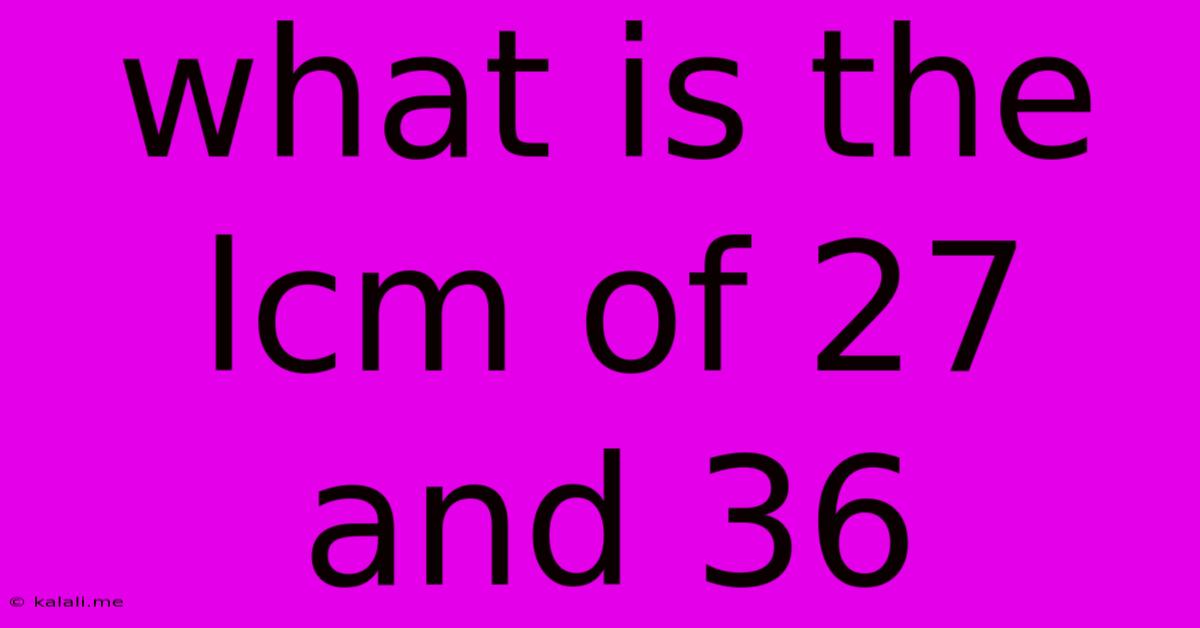What Is The Lcm Of 27 And 36
Kalali
Jun 14, 2025 · 3 min read

Table of Contents
What is the LCM of 27 and 36? A Comprehensive Guide
Finding the least common multiple (LCM) of two numbers is a fundamental concept in mathematics, with applications ranging from simple fraction addition to more complex algebraic manipulations. This article will guide you through the process of calculating the LCM of 27 and 36, explaining the different methods available and highlighting their practical uses. Understanding LCMs is crucial for various mathematical operations and problem-solving scenarios. Let's dive in!
What is the Least Common Multiple (LCM)?
The least common multiple (LCM) of two or more integers is the smallest positive integer that is divisible by all the integers. In simpler terms, it's the smallest number that both numbers can divide into evenly. Understanding this definition is key to solving LCM problems.
Methods for Calculating the LCM of 27 and 36
There are several ways to find the LCM of 27 and 36. Let's explore the two most common methods:
1. Listing Multiples Method
This method involves listing the multiples of each number until you find the smallest multiple that is common to both.
- Multiples of 27: 27, 54, 81, 108, 135, 162, 189, 216, 243, 270...
- Multiples of 36: 36, 72, 108, 144, 180, 216, 252, 288, 324, 360...
By comparing the lists, we can see that the smallest common multiple is 108. Therefore, the LCM of 27 and 36 is 108. While this method is straightforward for smaller numbers, it can become cumbersome with larger numbers.
2. Prime Factorization Method
This method is more efficient, especially for larger numbers. It involves finding the prime factorization of each number and then constructing the LCM using the highest powers of each prime factor.
- Prime factorization of 27: 3 x 3 x 3 = 3³
- Prime factorization of 36: 2 x 2 x 3 x 3 = 2² x 3²
To find the LCM, we take the highest power of each prime factor present in either factorization:
- Highest power of 2: 2² = 4
- Highest power of 3: 3³ = 27
Now, multiply these highest powers together: 4 x 27 = 108. This confirms that the LCM of 27 and 36 is indeed 108. This method is generally preferred for its efficiency and scalability.
Applications of LCM
Understanding and calculating the LCM has many practical applications in various fields:
- Adding and Subtracting Fractions: Finding a common denominator when adding or subtracting fractions requires finding the LCM of the denominators.
- Scheduling Problems: Determining when events will occur simultaneously, such as the overlapping of bus schedules or the synchronization of machinery.
- Music Theory: Calculating the frequency of rhythmic patterns and harmonies.
- Modular Arithmetic: Solving congruence problems.
Conclusion
Determining the LCM of 27 and 36, whether using the listing multiples method or the prime factorization method, results in the same answer: 108. The prime factorization method is generally more efficient and applicable to larger numbers. Understanding LCMs is essential for various mathematical applications beyond simply finding the smallest common multiple. This knowledge is a valuable tool in many mathematical and real-world scenarios.
Latest Posts
Latest Posts
-
Increasing Wavelength Of Light Goes In This Order
Jun 14, 2025
-
Are Pounds And Kg The Same
Jun 14, 2025
-
What Is The Antonym Of Frugal
Jun 14, 2025
-
What Is The Rhyme Scheme Of The First Stanza
Jun 14, 2025
-
Average Sat Score For Kennesaw State University
Jun 14, 2025
Related Post
Thank you for visiting our website which covers about What Is The Lcm Of 27 And 36 . We hope the information provided has been useful to you. Feel free to contact us if you have any questions or need further assistance. See you next time and don't miss to bookmark.